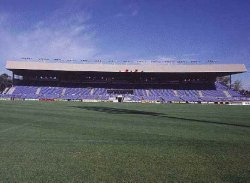
| The Stewart Stand at Belmore Sports Ground (formerly Belmore Oval). The grandstand seats 5600 whilst the terrace has seating for an additional 2500. The ground record of 27,804 was set on April 12 1993. |  Photo from Official Bulldogs Website |
| Switchboard: | 02 9789 2922 |
| Fax: | 02 9718 8102 |
| Email: | contact@bulldogs.com.au |
| Postal address: | PO Box 123 Belmore NSW 2192 Australia |
| Delivery address: | Belmore Sports Ground, Edison Lane (off Leylands Parade) Belmore |
| Capacity: | 28,000 |
| Grandstand seating (Stewart Stand): | 5,600 |
| Terrace seating: | 2,500 |
| Attendance record: | 27,804 v Parramatta, 12 April 1993 |
| Car parking: | 1,000 spaces (behind hill) |
| Corporate boxes: | back of Stewart Stand |
Admission prices |
|
| Outer ground: | $10 (adult) $4 (child) CHILDREN UNDER 12 FREE |
| Terrace seating: | $12 (adult) $6 (child) |
| Grandstand: | $17 (adult) $9 (child) |
| Ground info: | The northern end of the ground is commonly referred to as "the Railway end". The southern end is usually called the Canterbury Road end. The TV arc faces the eastern sideline towards Sydney. The Media Box is now in the old Peter Moore scoreboard. There are four radio broadcast boxes (ABC, 2UE & 2GB plus one kept available for visiting team's radio stations. |
| Directions: | by road: If coming from the city,
turn right into Thorncraft Parade (immediately before Canterbury Hospital), first set of
traffic lights after Campsie/Bexley turn-off. Follow Thorncraft Parade through to
the roundabout at the bottom of the hill, turn left into Palmer Street, then right at
Tudor Street. You'll find the carpark entrance clearly marked. by rail: alight at Belmore Station. Main entrance 200m from railway station, through Terry Lamb Reserve. |
| Venue Manager/Groundsman: | Warren Skuse 015 216 048 |
| Belmore Sports Ground, as it was renamed, was officially
opened on March 31, 1968 and provided Canterbury with a rectangular shaped ground,
conducive for watching Rugby League. Until then, the ground was oval in shape, and
it had been shared with cricket. It was officially known as Belmore Oval. The
ground first began to take shape back in 1920, two years before the Canterbury junior
league was formed. Steps were taken to acquire park sites at Belmore and one of them
was an area which is now Belmore-Campsie Park. It was opened in April 1921. The park
covered an area of 22 acres, which included the oval, children's playground and bowling
club. The first cricket wicket was laid in 1922 and the oval was fenced in 1931. However, the only Rugby League played on the ground was at junior level. When Canterbury was accepted into the grade competition in 1935, the Belmore complex was the ideal and obvious venue for home matches. In fact, the league made it a stipulation that the club had to have a first class, enclosed ground before they could be admitted to the premiership. But Belmore wasn't ready in 1935, and the league allowed Canterbury in on the proviso that they would have the ground prepared and ready by 1936. Training for the 1935 team was held on an old cow paddock called McMahon's Paddock. During 1935 the club, with help from its patron, Alderman S.E. Parry, the then mayor of Canterbury, purchased the old Smoko Members Stand at the northern end of the Sydney Cricket Ground. It was transported piece by piece to Belmore and erected on the western side of the ground ready for the official opening on March 14, 1936. It was named the Parry Pavilion. Like most major grounds in Sydney, Belmore was basically a cricket oval with a football field in the middle. In England it was rare for football clubs and cricket to share one ground. Thus, most of the football grounds were rectangular in shape and brought spectators considerably closer to the action. Such was Canterbury's intention, and in 1968, the ground went from Belmore Oval to Belmore Sports Ground. On a pre-season night match that year more than 20,000 spectators watched Canterbury play Western Suburbs. The highest attendance at Belmore Oval was 16,413 when Canterbury played Wests in 1967. However the ground was left without a grandstand when reconstruction was completed in 1968. The old Parry Pavilion was unusable since the club had built up the area along the western side of the ground, thereby blocking the view from the old stand. The first stage of the new look ground cost $200,000 - Canterbury Football Club, Canterbury League Club, and the NSW Rugby League sharing the cost of $100,000 and the council matching them dollar for dollar. The second stage was the building of a major new stand, and improvement in amenities. This stage was completed in 1980, significantly a premiership year for the Bulldogs. The new stand, financed by sponsorship money from Rothmans, Tooth and Co and Amatil as well as an interest free loan of $150,000 from the NSW Rugby League, and a bank loan repaid by the Canterbury League Club, was named the Stewart Stand. It ran almost the length of the field and cost $1.8 million. The late Frank Stewart was a former player, club president (1952-1961), co-patron and a member of parliament, a man who was held in high esteem in the area. Text reproduced from the Official Bulldogs Website |